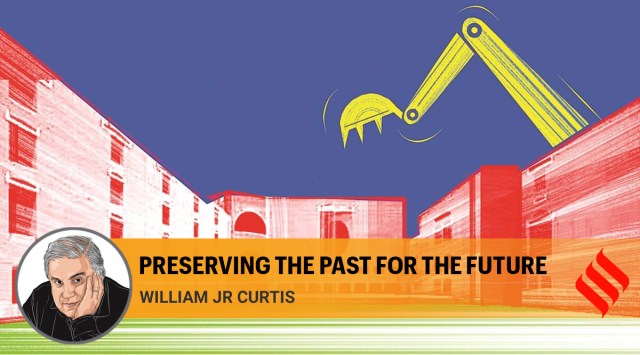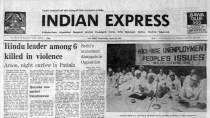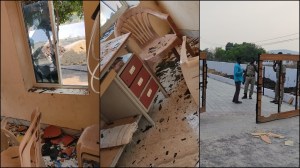- India
- International
Louis Kahn’s masterpiece in Ahmedabad must be preserved in its entirety
It is the intangible spirit, the underlying metaphysical order, which lends Louis Kahn’s architecture its power. His masterpiece in Ahmedabad must be preserved in its entirety, restored from one end to the other.
 The administration of the IIMA recently announced it intended to knock down most of the dormitories in Kahn’s masterpiece. (Illustration: C R Sasikumar)
The administration of the IIMA recently announced it intended to knock down most of the dormitories in Kahn’s masterpiece. (Illustration: C R Sasikumar)Great architecture communicates before it is understood. It touches the mind, the senses and the body of the observer and imposes itself on the imagination through its underlying order. While a work of architecture is created in a particular period, it may nonetheless continue to move us over the centuries through the power of its spaces and forms. Buildings embody the values, political ideologies and dominant beliefs of their time but they do not express these directly, as they are idealisations of social institutions. They resemble constructed myths symbolising the cosmic order or supplying visions of the way the world ought to be. A great work fuses diverse influences and traditions in a fresh synthesis of idea and form, image and material. It combines the unique with the universal, the present with the past. It is timeless but of its time.
For 40 years I have been roaming from one end of India to the other, experiencing, admiring and studying outstanding buildings and sites of all eras, from the most ancient to the most recent. The Buddhist stupa at Sanchi, the Hindu temples at Khajuraho, the Jain temple at Ranakpur, the tomb of Humayun — these are to me like architectural friends. They occupy a place in my memory and my inner life. How can one forget the sensation of moving from light to dark in the Elephanta caves with the dim sculptures of the dancing Shiva and Parvati in the background? Or the floating levels in red sandstone at Fatehpur Sikri experienced at dawn? Works of this calibre belong to both national and universal heritage. They are among the greatest creations in the history of humanity and are protected by both national laws of patrimony and international decrees underlining their cultural, aesthetic and spiritual value.
When one comes to the 20th century, the concept of “architectural heritage” scarcely exists in a formal sense in Indian mentalities or legislation. Buildings and sites have to be over a century old to be considered “heritage” at all. This is both negligent and tragic for India also has within its boundaries some of the major masterpieces of modern architecture world-wide, such as Le Corbusier’s Assembly and High Court in Chandigarh, his Ahmedabad Textile Mill Owners’ Association House (ATMA), or Louis I Kahn’s Indian Institute of Management (IIMA) also in Ahmedabad. As of 2016, Chandigarh achieved definition as a UNESCO World Heritage site after a massive though incomplete programme of restoration. But key modern buildings in Ahmedabad remain vulnerable to destruction.
The recent announcement by the administration of the IIMA that it intends to knock down most of the dormitories in Kahn’s masterpiece while keeping only the library/ teaching block as an example of “heritage” — on Friday, the board of governors of the IIM wrote to the stakeholders saying it is withdrawing the Expression of Interest that sought bids for the reconstruction — would be like slicing off a chunk of a temple complex and then claiming that the remaining fragments represent a successful example of preservation. Having supported the restoration of the entire campus for years, the leaders of the institution suddenly made a u-turn on a flimsy pretext that the trial restoration on one of the dormitories was “unsatisfactory”, a judgement contested by international experts. Thankfully, this act of cultural vandalism is being challenged from all sides, by committed individuals, by prestigious institutions and by articles in the national and international press. But nothing is certain in the current state of anarchy in India: Raj Rewal’s Hall of Nations and Nehru Memorial Pavilion in New Delhi were demolished three years ago while under judicial review, both of them key monuments in India’s post-colonial history.
Such are the dangers of a neo-liberal ideology which emphasises private profit at the expense of professional probity and long-term public interest. Today laissez-faire capitalism, political corruption and land speculation pose threats to ancient and modern works of quality. In a society where it is “the price of everything and the value of nothing”, there is insufficient interest in the cultural enrichment provided by fine modern buildings. During a visit to Ahmedabad in 2014 I realised just how vulnerable works by Le Corbusier, Louis Kahn, Balkrishna Doshi, Charles Correa, and Anant Raje had become. I sounded the alarm in several other texts: “Nothing is Sacred: Threats to Modern Masterpieces in India” (Architectural Review, 2014) and “Protecting Modern Masterpieces in India” (Architecture + Design, 2014). I stressed the urgency of changing national heritage laws so as to include and protect 20th century buildings, arguing that patrimony should be assessed on the basis of long-term quality rather than the cut-off date of a hundred years.

Without repeating the myth of an “Eternal India” one can suggest that deep structures are rethought in each period, sometimes being fused with imported forms. Modern architecture is the latest “invader” and it has gradually been modified to meet local conditions, climates and conceptions of space. One of the key figures in this process of “naturalisation” was Louis Kahn who, while remaining resolutely modern, was inspired by essentials in tradition. On the Indian sub-continent he created two of his most profound masterpieces: The National Assembly Complex in Dhaka, and the Indian Institute of Management in Ahmedabad. With the former he grappled with the problem of a democratic monumentality by fusing modern architectural abstraction with a profound transformation of centralised archetypes in Bengali traditions, including mosques of the Sultanate period and ruined Buddhist stupas, monasteries and mandala plans. Kahn symbolised the state with a cosmic geometry of sorts.
In Dhaka Kahn built in concrete, in Ahmedabad he chose brick, but his materials also included space, light and shadow. Architecture communicates by its own means in silence and has its immaterial aspect. It is the intangible spirit, the aura, the underlying metaphysical order, which lends Kahn’s architecture its power. In his project for IIM, he employed shaded layers of structure and bold openings for cross ventilation to protect from the searing climate. In defining the essential nature of a teaching institution, he sought a balance between individual and community while providing transitions between them. He distinguished between library, administration and lecture halls, and student residences, but integrated all in a unified concept, a citadel of learning where spaces between are as important as the buildings themselves. Kahn was inspired by monasteries with their cloisters, courts and private cells, and by the outdoor rooms in the Palace complex at Mandu (15th C). The brick cylinders at IIM owe something to the Cathedral at Albi (14th C) in south west France.
The plan of the campus at IIM reveals Kahn’s prodigious skill in weaving together solids and voids, rectangles and triangles, orthogonal and diagonal geometries. It is like a map of human relationships, an idealisation of the human interchange of knowledge in an institution of learning. Alas the temporary tenants of this masterpiece, the director and board of IIM, do not seem to understand that they have a responsibility to bequeath this great work in its totality to future generations so that they may be inspired by it. The director stated recently that it was hard to accept that a set of buildings only half a century old might be considered as “heritage”. He could not have been more wrong. Kahn’s masterpiece in Ahmedabad must be preserved in its entirety, restored from one end to the other, and given the same status and universal heritage protection as the great monuments in India’s past.
This article first appeared in the print edition on January 2, 2021 under the title ‘Preserving the past for the future’. The writer is an historian, critic, artist and photographer, the author of Modern Architecture Since 1900, Le Corbusier: Ideas and Forms, and Balkrishna Doshi: An Architecture for India. In 2014 he received the Golden Award for Global Contribution to Architecture (CERA, India).
40 Years Ago
EXPRESS OPINION
More Explained
Apr 18: Latest News
- 01
- 02
- 03
- 04
- 05









































